Research Report: Heart Disease, Exercise, and Data Analysis (HSC4900)
VerifiedAdded on 2022/10/04
|9
|1820
|24
Report
AI Summary
This report presents a descriptive research study investigating the association between physical exercise and the incidence of heart disease. The study utilizes data from the CDC's Behavioral Risk Factor Surveillance System (BRFSS) of 2018, focusing on United States residents aged 18 and older. The research employs surveys and questionnaires for data collection, with a sample of 437,436 respondents across various states. The report details the methods, including the selection of participants using the Random Digit Dialing technique and the use of the BRFSS questionnaire. It defines the independent variable as heart attack history and the dependent variable as physical exercise participation. Covariates such as job type, transportation methods, time spent on activities, and frequency of exercise are also considered. Statistical analysis is performed using multi-variable linear regression in SPSS V25, with a p-value of less than 0.05 used to determine statistical significance. The study aims to provide insights into how physical activity is associated with heart disease prevention. The report concludes by referencing relevant sources including CDC and research papers.
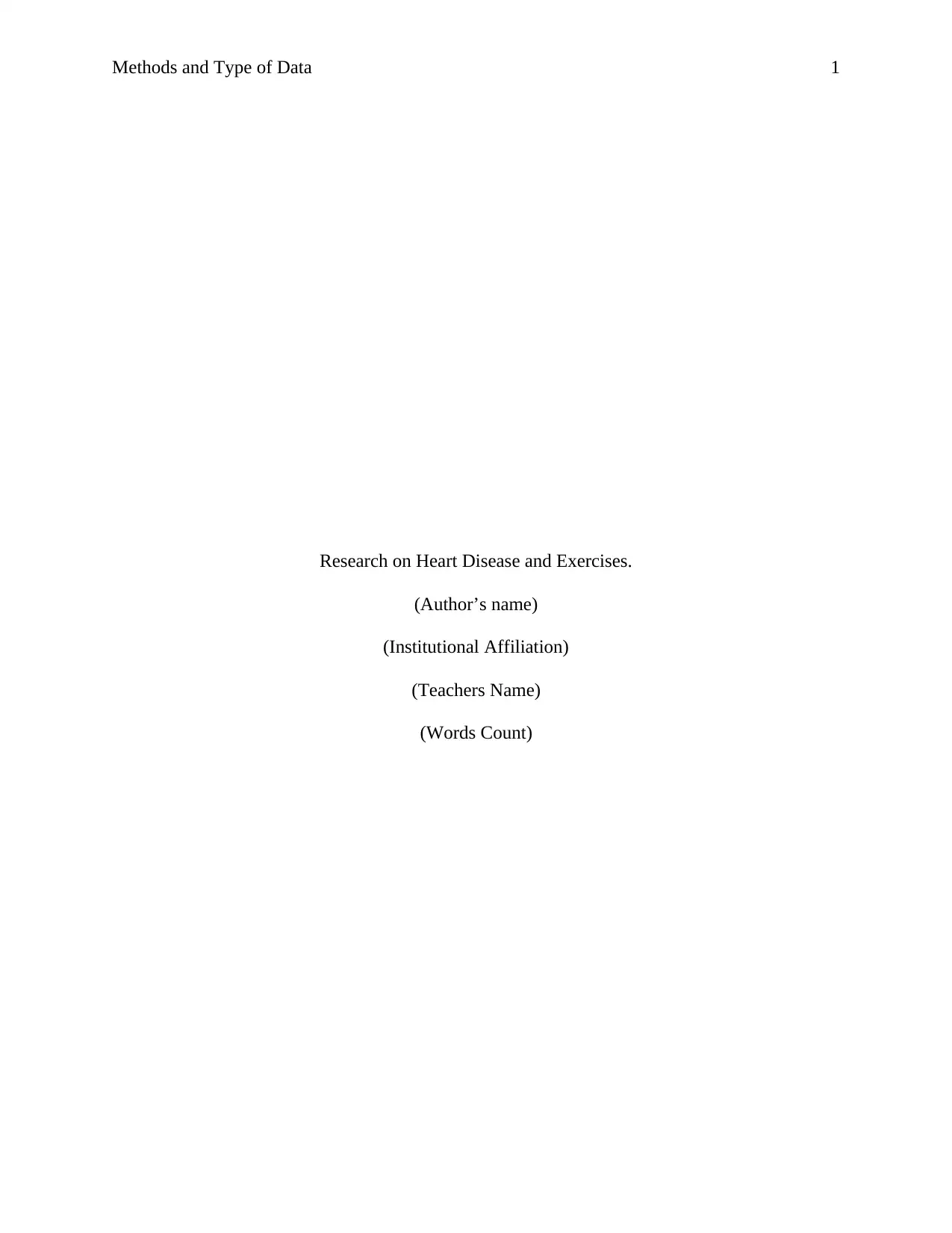
Methods and Type of Data 1
Research on Heart Disease and Exercises.
(Author’s name)
(Institutional Affiliation)
(Teachers Name)
(Words Count)
Research on Heart Disease and Exercises.
(Author’s name)
(Institutional Affiliation)
(Teachers Name)
(Words Count)
Paraphrase This Document
Need a fresh take? Get an instant paraphrase of this document with our AI Paraphraser
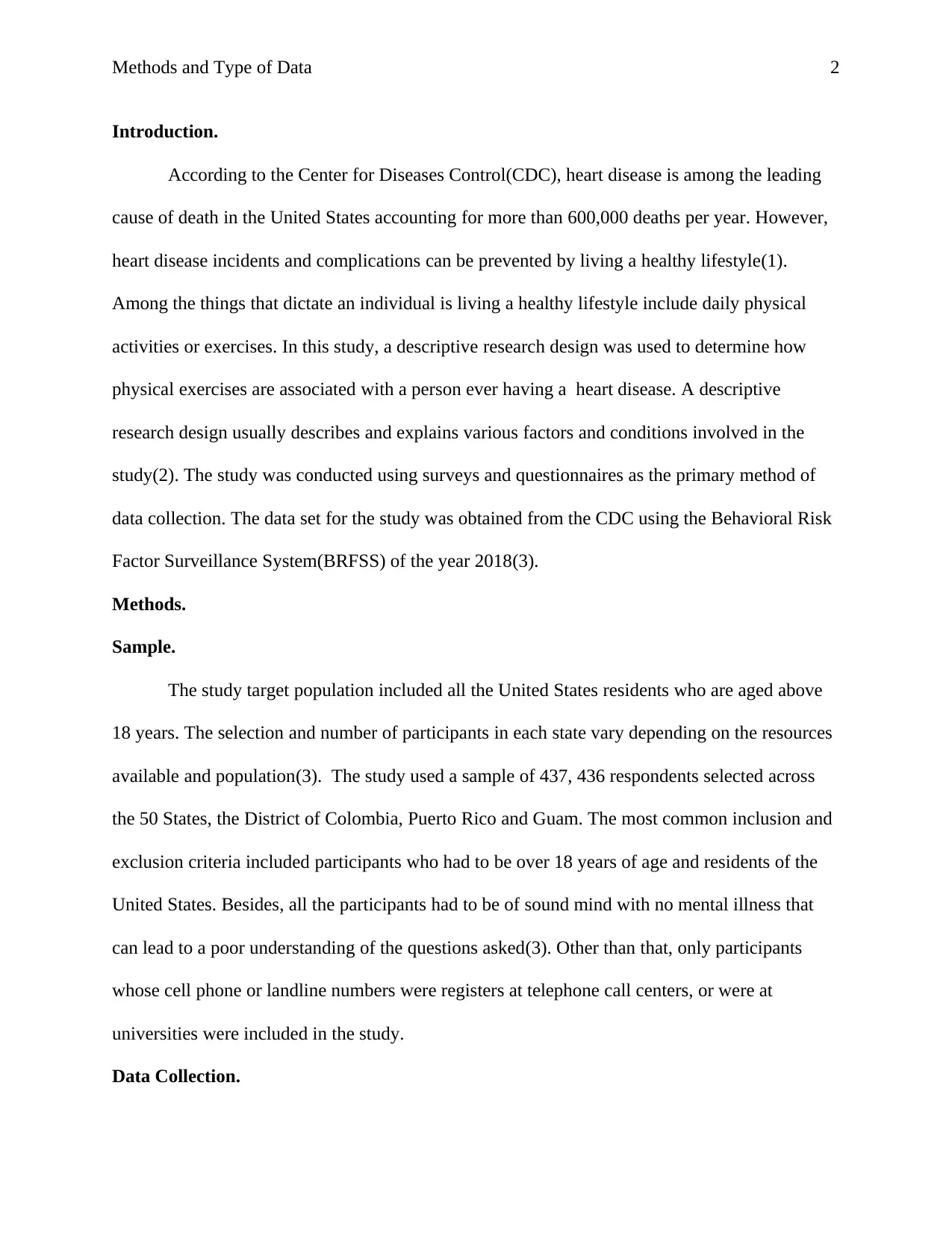
Methods and Type of Data 2
Introduction.
According to the Center for Diseases Control(CDC), heart disease is among the leading
cause of death in the United States accounting for more than 600,000 deaths per year. However,
heart disease incidents and complications can be prevented by living a healthy lifestyle(1).
Among the things that dictate an individual is living a healthy lifestyle include daily physical
activities or exercises. In this study, a descriptive research design was used to determine how
physical exercises are associated with a person ever having a heart disease. A descriptive
research design usually describes and explains various factors and conditions involved in the
study(2). The study was conducted using surveys and questionnaires as the primary method of
data collection. The data set for the study was obtained from the CDC using the Behavioral Risk
Factor Surveillance System(BRFSS) of the year 2018(3).
Methods.
Sample.
The study target population included all the United States residents who are aged above
18 years. The selection and number of participants in each state vary depending on the resources
available and population(3). The study used a sample of 437, 436 respondents selected across
the 50 States, the District of Colombia, Puerto Rico and Guam. The most common inclusion and
exclusion criteria included participants who had to be over 18 years of age and residents of the
United States. Besides, all the participants had to be of sound mind with no mental illness that
can lead to a poor understanding of the questions asked(3). Other than that, only participants
whose cell phone or landline numbers were registers at telephone call centers, or were at
universities were included in the study.
Data Collection.
Introduction.
According to the Center for Diseases Control(CDC), heart disease is among the leading
cause of death in the United States accounting for more than 600,000 deaths per year. However,
heart disease incidents and complications can be prevented by living a healthy lifestyle(1).
Among the things that dictate an individual is living a healthy lifestyle include daily physical
activities or exercises. In this study, a descriptive research design was used to determine how
physical exercises are associated with a person ever having a heart disease. A descriptive
research design usually describes and explains various factors and conditions involved in the
study(2). The study was conducted using surveys and questionnaires as the primary method of
data collection. The data set for the study was obtained from the CDC using the Behavioral Risk
Factor Surveillance System(BRFSS) of the year 2018(3).
Methods.
Sample.
The study target population included all the United States residents who are aged above
18 years. The selection and number of participants in each state vary depending on the resources
available and population(3). The study used a sample of 437, 436 respondents selected across
the 50 States, the District of Colombia, Puerto Rico and Guam. The most common inclusion and
exclusion criteria included participants who had to be over 18 years of age and residents of the
United States. Besides, all the participants had to be of sound mind with no mental illness that
can lead to a poor understanding of the questions asked(3). Other than that, only participants
whose cell phone or landline numbers were registers at telephone call centers, or were at
universities were included in the study.
Data Collection.
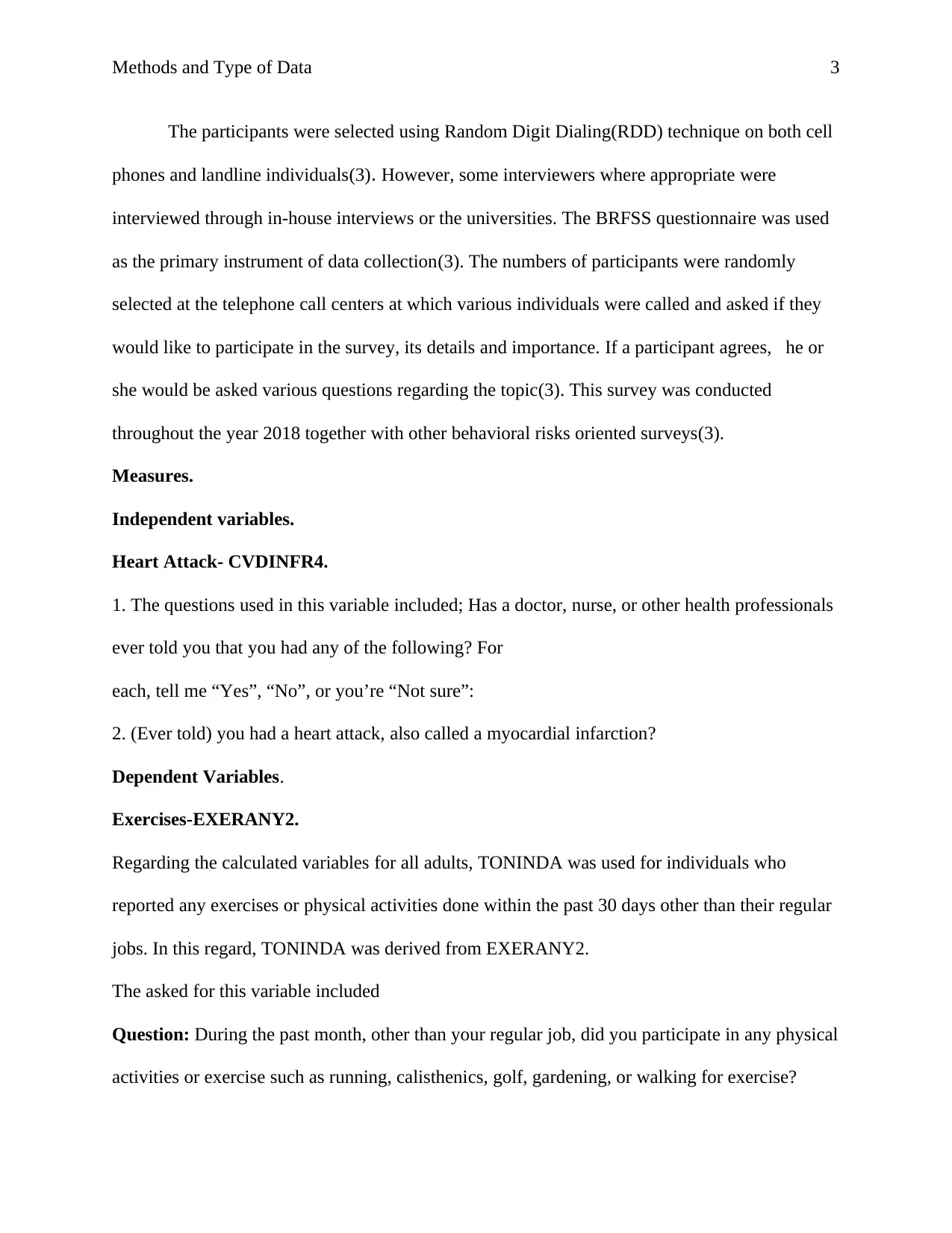
Methods and Type of Data 3
The participants were selected using Random Digit Dialing(RDD) technique on both cell
phones and landline individuals(3). However, some interviewers where appropriate were
interviewed through in-house interviews or the universities. The BRFSS questionnaire was used
as the primary instrument of data collection(3). The numbers of participants were randomly
selected at the telephone call centers at which various individuals were called and asked if they
would like to participate in the survey, its details and importance. If a participant agrees, he or
she would be asked various questions regarding the topic(3). This survey was conducted
throughout the year 2018 together with other behavioral risks oriented surveys(3).
Measures.
Independent variables.
Heart Attack- CVDINFR4.
1. The questions used in this variable included; Has a doctor, nurse, or other health professionals
ever told you that you had any of the following? For
each, tell me “Yes”, “No”, or you’re “Not sure”:
2. (Ever told) you had a heart attack, also called a myocardial infarction?
Dependent Variables.
Exercises-EXERANY2.
Regarding the calculated variables for all adults, TONINDA was used for individuals who
reported any exercises or physical activities done within the past 30 days other than their regular
jobs. In this regard, TONINDA was derived from EXERANY2.
The asked for this variable included
Question: During the past month, other than your regular job, did you participate in any physical
activities or exercise such as running, calisthenics, golf, gardening, or walking for exercise?
The participants were selected using Random Digit Dialing(RDD) technique on both cell
phones and landline individuals(3). However, some interviewers where appropriate were
interviewed through in-house interviews or the universities. The BRFSS questionnaire was used
as the primary instrument of data collection(3). The numbers of participants were randomly
selected at the telephone call centers at which various individuals were called and asked if they
would like to participate in the survey, its details and importance. If a participant agrees, he or
she would be asked various questions regarding the topic(3). This survey was conducted
throughout the year 2018 together with other behavioral risks oriented surveys(3).
Measures.
Independent variables.
Heart Attack- CVDINFR4.
1. The questions used in this variable included; Has a doctor, nurse, or other health professionals
ever told you that you had any of the following? For
each, tell me “Yes”, “No”, or you’re “Not sure”:
2. (Ever told) you had a heart attack, also called a myocardial infarction?
Dependent Variables.
Exercises-EXERANY2.
Regarding the calculated variables for all adults, TONINDA was used for individuals who
reported any exercises or physical activities done within the past 30 days other than their regular
jobs. In this regard, TONINDA was derived from EXERANY2.
The asked for this variable included
Question: During the past month, other than your regular job, did you participate in any physical
activities or exercise such as running, calisthenics, golf, gardening, or walking for exercise?
⊘ This is a preview!⊘
Do you want full access?
Subscribe today to unlock all pages.

Trusted by 1+ million students worldwide
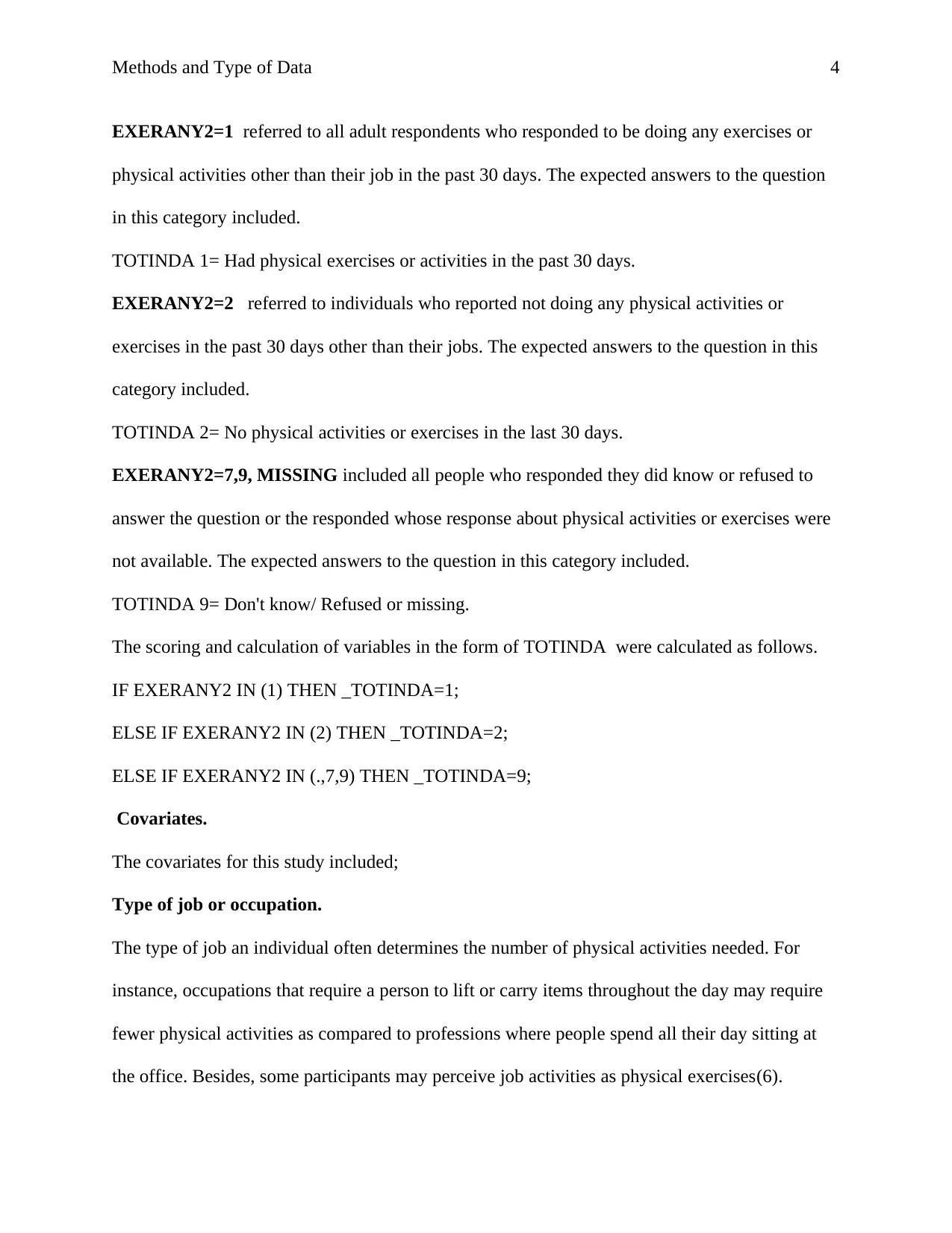
Methods and Type of Data 4
EXERANY2=1 referred to all adult respondents who responded to be doing any exercises or
physical activities other than their job in the past 30 days. The expected answers to the question
in this category included.
TOTINDA 1= Had physical exercises or activities in the past 30 days.
EXERANY2=2 referred to individuals who reported not doing any physical activities or
exercises in the past 30 days other than their jobs. The expected answers to the question in this
category included.
TOTINDA 2= No physical activities or exercises in the last 30 days.
EXERANY2=7,9, MISSING included all people who responded they did know or refused to
answer the question or the responded whose response about physical activities or exercises were
not available. The expected answers to the question in this category included.
TOTINDA 9= Don't know/ Refused or missing.
The scoring and calculation of variables in the form of TOTINDA were calculated as follows.
IF EXERANY2 IN (1) THEN _TOTINDA=1;
ELSE IF EXERANY2 IN (2) THEN _TOTINDA=2;
ELSE IF EXERANY2 IN (.,7,9) THEN _TOTINDA=9;
Covariates.
The covariates for this study included;
Type of job or occupation.
The type of job an individual often determines the number of physical activities needed. For
instance, occupations that require a person to lift or carry items throughout the day may require
fewer physical activities as compared to professions where people spend all their day sitting at
the office. Besides, some participants may perceive job activities as physical exercises(6).
EXERANY2=1 referred to all adult respondents who responded to be doing any exercises or
physical activities other than their job in the past 30 days. The expected answers to the question
in this category included.
TOTINDA 1= Had physical exercises or activities in the past 30 days.
EXERANY2=2 referred to individuals who reported not doing any physical activities or
exercises in the past 30 days other than their jobs. The expected answers to the question in this
category included.
TOTINDA 2= No physical activities or exercises in the last 30 days.
EXERANY2=7,9, MISSING included all people who responded they did know or refused to
answer the question or the responded whose response about physical activities or exercises were
not available. The expected answers to the question in this category included.
TOTINDA 9= Don't know/ Refused or missing.
The scoring and calculation of variables in the form of TOTINDA were calculated as follows.
IF EXERANY2 IN (1) THEN _TOTINDA=1;
ELSE IF EXERANY2 IN (2) THEN _TOTINDA=2;
ELSE IF EXERANY2 IN (.,7,9) THEN _TOTINDA=9;
Covariates.
The covariates for this study included;
Type of job or occupation.
The type of job an individual often determines the number of physical activities needed. For
instance, occupations that require a person to lift or carry items throughout the day may require
fewer physical activities as compared to professions where people spend all their day sitting at
the office. Besides, some participants may perceive job activities as physical exercises(6).
Paraphrase This Document
Need a fresh take? Get an instant paraphrase of this document with our AI Paraphraser
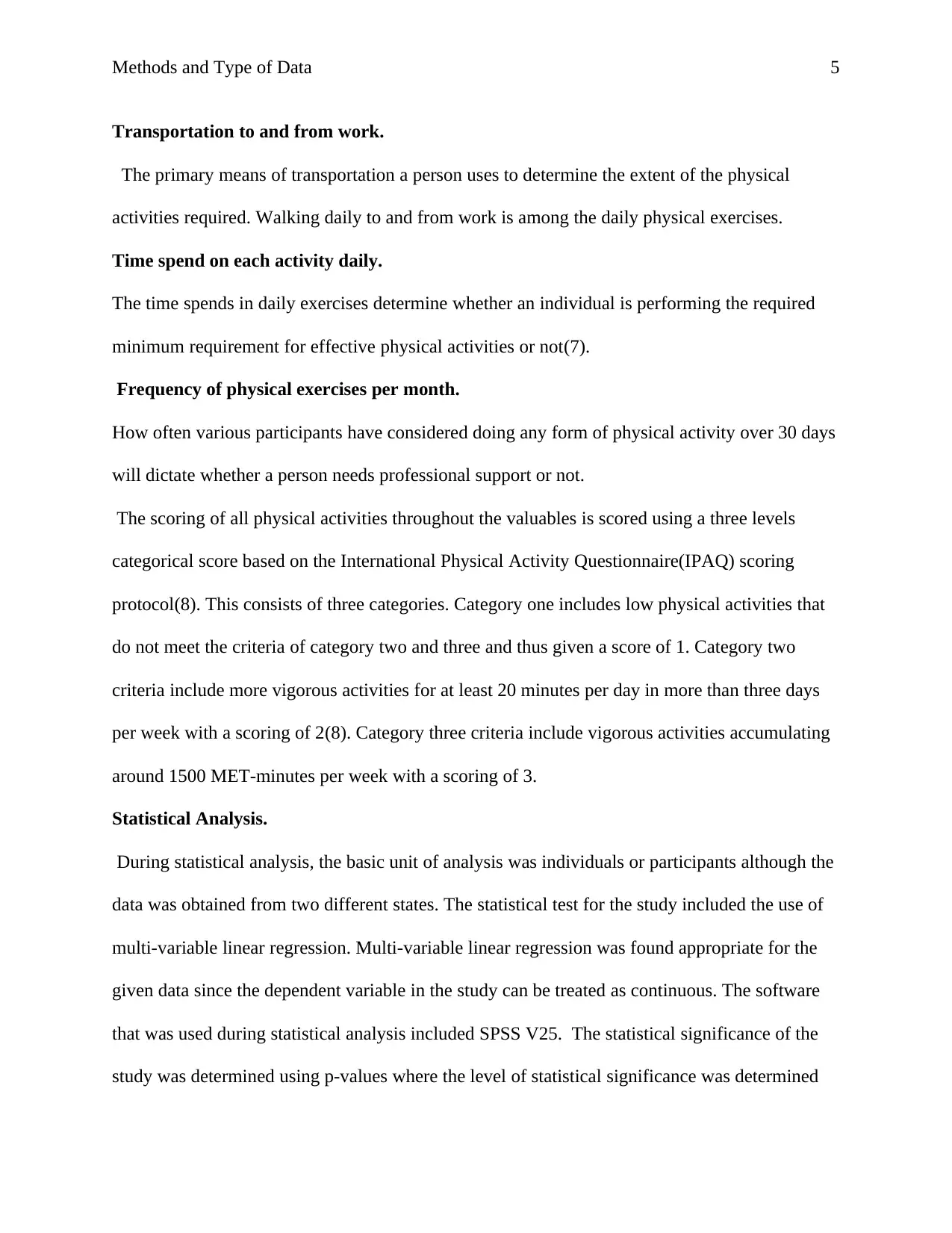
Methods and Type of Data 5
Transportation to and from work.
The primary means of transportation a person uses to determine the extent of the physical
activities required. Walking daily to and from work is among the daily physical exercises.
Time spend on each activity daily.
The time spends in daily exercises determine whether an individual is performing the required
minimum requirement for effective physical activities or not(7).
Frequency of physical exercises per month.
How often various participants have considered doing any form of physical activity over 30 days
will dictate whether a person needs professional support or not.
The scoring of all physical activities throughout the valuables is scored using a three levels
categorical score based on the International Physical Activity Questionnaire(IPAQ) scoring
protocol(8). This consists of three categories. Category one includes low physical activities that
do not meet the criteria of category two and three and thus given a score of 1. Category two
criteria include more vigorous activities for at least 20 minutes per day in more than three days
per week with a scoring of 2(8). Category three criteria include vigorous activities accumulating
around 1500 MET-minutes per week with a scoring of 3.
Statistical Analysis.
During statistical analysis, the basic unit of analysis was individuals or participants although the
data was obtained from two different states. The statistical test for the study included the use of
multi-variable linear regression. Multi-variable linear regression was found appropriate for the
given data since the dependent variable in the study can be treated as continuous. The software
that was used during statistical analysis included SPSS V25. The statistical significance of the
study was determined using p-values where the level of statistical significance was determined
Transportation to and from work.
The primary means of transportation a person uses to determine the extent of the physical
activities required. Walking daily to and from work is among the daily physical exercises.
Time spend on each activity daily.
The time spends in daily exercises determine whether an individual is performing the required
minimum requirement for effective physical activities or not(7).
Frequency of physical exercises per month.
How often various participants have considered doing any form of physical activity over 30 days
will dictate whether a person needs professional support or not.
The scoring of all physical activities throughout the valuables is scored using a three levels
categorical score based on the International Physical Activity Questionnaire(IPAQ) scoring
protocol(8). This consists of three categories. Category one includes low physical activities that
do not meet the criteria of category two and three and thus given a score of 1. Category two
criteria include more vigorous activities for at least 20 minutes per day in more than three days
per week with a scoring of 2(8). Category three criteria include vigorous activities accumulating
around 1500 MET-minutes per week with a scoring of 3.
Statistical Analysis.
During statistical analysis, the basic unit of analysis was individuals or participants although the
data was obtained from two different states. The statistical test for the study included the use of
multi-variable linear regression. Multi-variable linear regression was found appropriate for the
given data since the dependent variable in the study can be treated as continuous. The software
that was used during statistical analysis included SPSS V25. The statistical significance of the
study was determined using p-values where the level of statistical significance was determined

Methods and Type of Data 6
where an effect of physical activities towards heart disease prevention of the p-value was less
than 0.05.
where an effect of physical activities towards heart disease prevention of the p-value was less
than 0.05.
⊘ This is a preview!⊘
Do you want full access?
Subscribe today to unlock all pages.

Trusted by 1+ million students worldwide
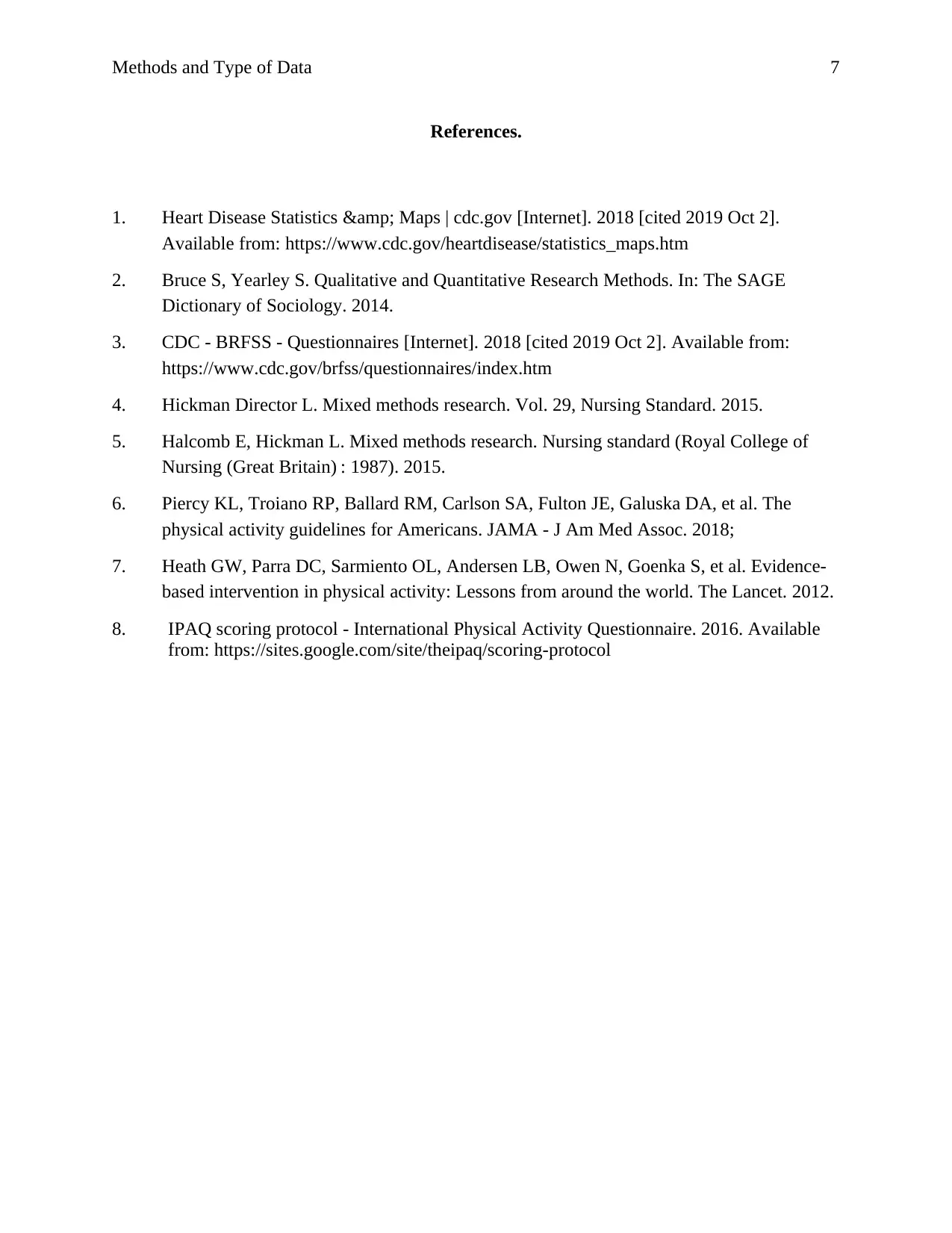
Methods and Type of Data 7
References.
1. Heart Disease Statistics & Maps | cdc.gov [Internet]. 2018 [cited 2019 Oct 2].
Available from: https://www.cdc.gov/heartdisease/statistics_maps.htm
2. Bruce S, Yearley S. Qualitative and Quantitative Research Methods. In: The SAGE
Dictionary of Sociology. 2014.
3. CDC - BRFSS - Questionnaires [Internet]. 2018 [cited 2019 Oct 2]. Available from:
https://www.cdc.gov/brfss/questionnaires/index.htm
4. Hickman Director L. Mixed methods research. Vol. 29, Nursing Standard. 2015.
5. Halcomb E, Hickman L. Mixed methods research. Nursing standard (Royal College of
Nursing (Great Britain) : 1987). 2015.
6. Piercy KL, Troiano RP, Ballard RM, Carlson SA, Fulton JE, Galuska DA, et al. The
physical activity guidelines for Americans. JAMA - J Am Med Assoc. 2018;
7. Heath GW, Parra DC, Sarmiento OL, Andersen LB, Owen N, Goenka S, et al. Evidence-
based intervention in physical activity: Lessons from around the world. The Lancet. 2012.
8. IPAQ scoring protocol - International Physical Activity Questionnaire. 2016. Available
from: https://sites.google.com/site/theipaq/scoring-protocol
References.
1. Heart Disease Statistics & Maps | cdc.gov [Internet]. 2018 [cited 2019 Oct 2].
Available from: https://www.cdc.gov/heartdisease/statistics_maps.htm
2. Bruce S, Yearley S. Qualitative and Quantitative Research Methods. In: The SAGE
Dictionary of Sociology. 2014.
3. CDC - BRFSS - Questionnaires [Internet]. 2018 [cited 2019 Oct 2]. Available from:
https://www.cdc.gov/brfss/questionnaires/index.htm
4. Hickman Director L. Mixed methods research. Vol. 29, Nursing Standard. 2015.
5. Halcomb E, Hickman L. Mixed methods research. Nursing standard (Royal College of
Nursing (Great Britain) : 1987). 2015.
6. Piercy KL, Troiano RP, Ballard RM, Carlson SA, Fulton JE, Galuska DA, et al. The
physical activity guidelines for Americans. JAMA - J Am Med Assoc. 2018;
7. Heath GW, Parra DC, Sarmiento OL, Andersen LB, Owen N, Goenka S, et al. Evidence-
based intervention in physical activity: Lessons from around the world. The Lancet. 2012.
8. IPAQ scoring protocol - International Physical Activity Questionnaire. 2016. Available
from: https://sites.google.com/site/theipaq/scoring-protocol
Paraphrase This Document
Need a fresh take? Get an instant paraphrase of this document with our AI Paraphraser
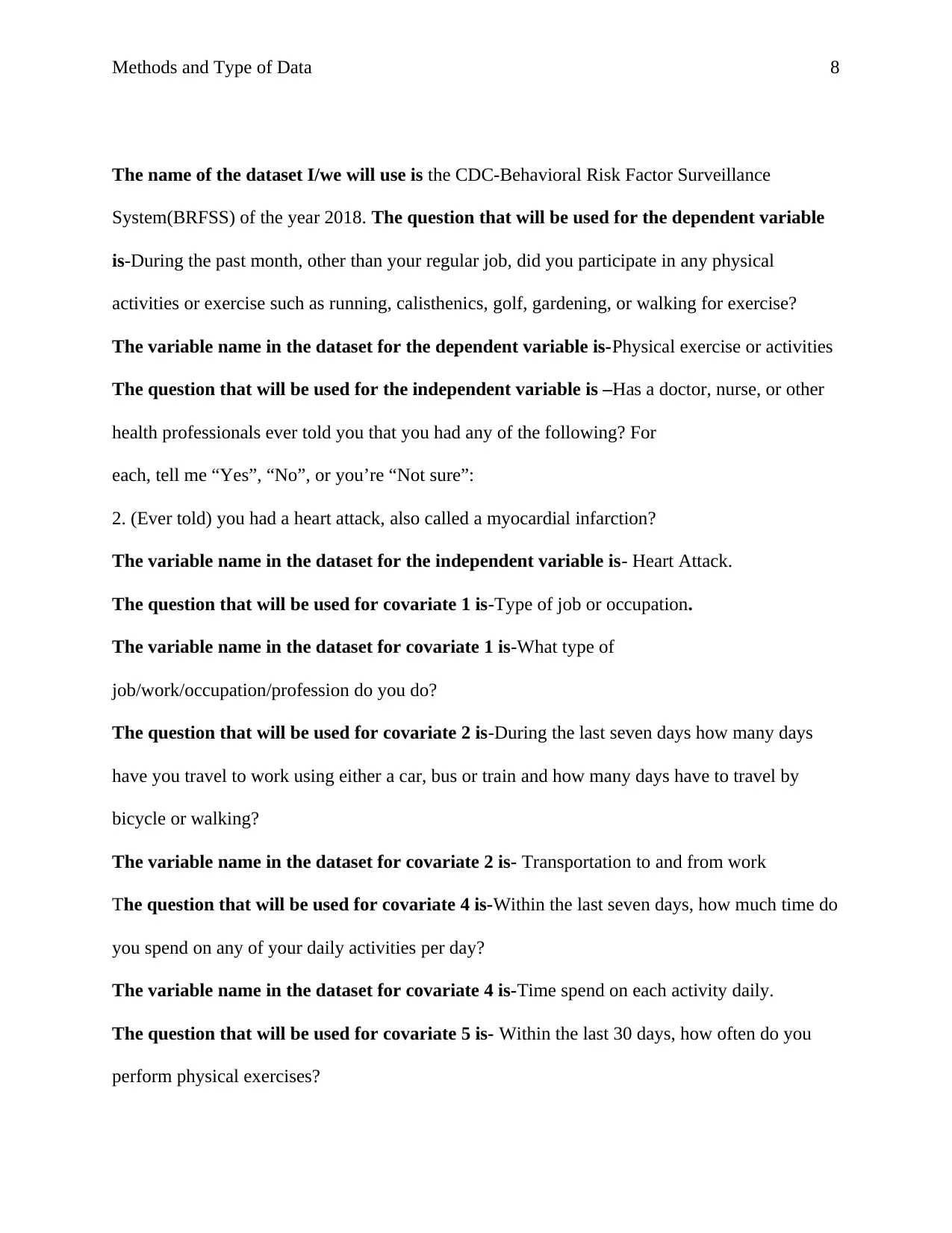
Methods and Type of Data 8
The name of the dataset I/we will use is the CDC-Behavioral Risk Factor Surveillance
System(BRFSS) of the year 2018. The question that will be used for the dependent variable
is-During the past month, other than your regular job, did you participate in any physical
activities or exercise such as running, calisthenics, golf, gardening, or walking for exercise?
The variable name in the dataset for the dependent variable is-Physical exercise or activities
The question that will be used for the independent variable is –Has a doctor, nurse, or other
health professionals ever told you that you had any of the following? For
each, tell me “Yes”, “No”, or you’re “Not sure”:
2. (Ever told) you had a heart attack, also called a myocardial infarction?
The variable name in the dataset for the independent variable is- Heart Attack.
The question that will be used for covariate 1 is-Type of job or occupation.
The variable name in the dataset for covariate 1 is-What type of
job/work/occupation/profession do you do?
The question that will be used for covariate 2 is-During the last seven days how many days
have you travel to work using either a car, bus or train and how many days have to travel by
bicycle or walking?
The variable name in the dataset for covariate 2 is- Transportation to and from work
The question that will be used for covariate 4 is-Within the last seven days, how much time do
you spend on any of your daily activities per day?
The variable name in the dataset for covariate 4 is-Time spend on each activity daily.
The question that will be used for covariate 5 is- Within the last 30 days, how often do you
perform physical exercises?
The name of the dataset I/we will use is the CDC-Behavioral Risk Factor Surveillance
System(BRFSS) of the year 2018. The question that will be used for the dependent variable
is-During the past month, other than your regular job, did you participate in any physical
activities or exercise such as running, calisthenics, golf, gardening, or walking for exercise?
The variable name in the dataset for the dependent variable is-Physical exercise or activities
The question that will be used for the independent variable is –Has a doctor, nurse, or other
health professionals ever told you that you had any of the following? For
each, tell me “Yes”, “No”, or you’re “Not sure”:
2. (Ever told) you had a heart attack, also called a myocardial infarction?
The variable name in the dataset for the independent variable is- Heart Attack.
The question that will be used for covariate 1 is-Type of job or occupation.
The variable name in the dataset for covariate 1 is-What type of
job/work/occupation/profession do you do?
The question that will be used for covariate 2 is-During the last seven days how many days
have you travel to work using either a car, bus or train and how many days have to travel by
bicycle or walking?
The variable name in the dataset for covariate 2 is- Transportation to and from work
The question that will be used for covariate 4 is-Within the last seven days, how much time do
you spend on any of your daily activities per day?
The variable name in the dataset for covariate 4 is-Time spend on each activity daily.
The question that will be used for covariate 5 is- Within the last 30 days, how often do you
perform physical exercises?

Methods and Type of Data 9
The variable name in the dataset for covariate 5 is-Frequency of physical exercises per
month.
The variable name in the dataset for covariate 5 is-Frequency of physical exercises per
month.
⊘ This is a preview!⊘
Do you want full access?
Subscribe today to unlock all pages.

Trusted by 1+ million students worldwide
1 out of 9
Related Documents
Your All-in-One AI-Powered Toolkit for Academic Success.
+13062052269
info@desklib.com
Available 24*7 on WhatsApp / Email
![[object Object]](/_next/static/media/star-bottom.7253800d.svg)
Unlock your academic potential
Copyright © 2020–2025 A2Z Services. All Rights Reserved. Developed and managed by ZUCOL.





